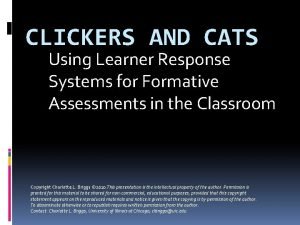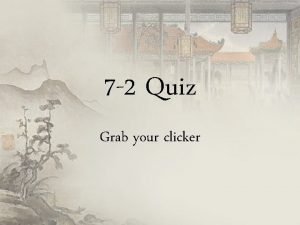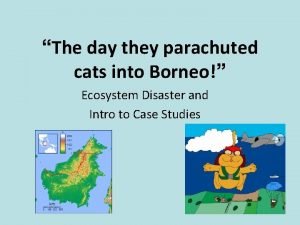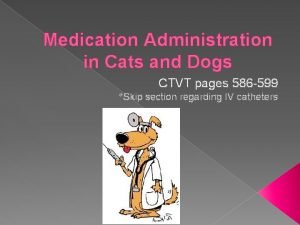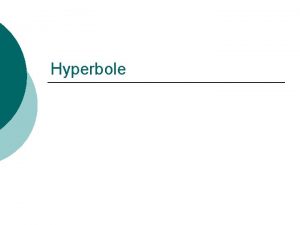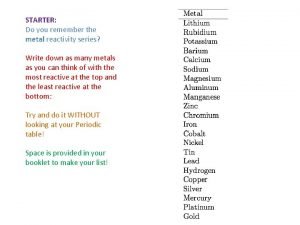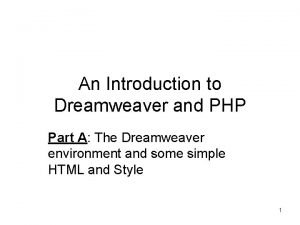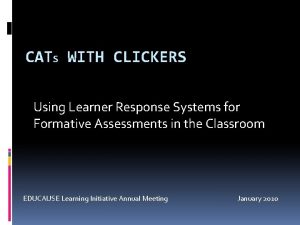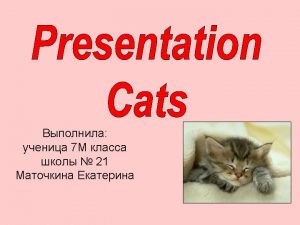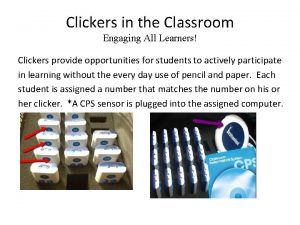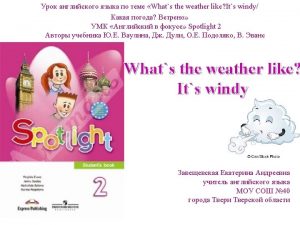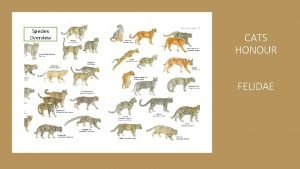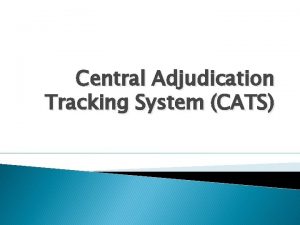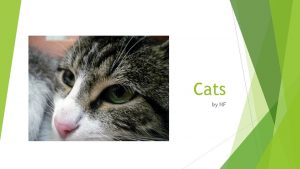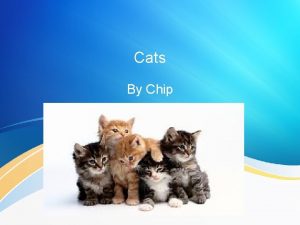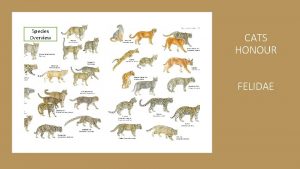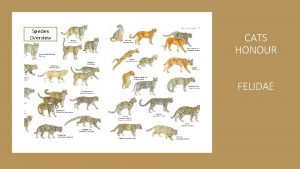CLICKERS AND CATS Using Learner Response Systems for







































- Slides: 39

CLICKERS AND CATS Using Learner Response Systems for Formative Assessments in the Classroom Copyright Charlotte L. Briggs © 2010. This presentation is the intellectual property of the author. Permission is granted for this material to be shared for non-commercial, educational purposes, provided that this copyright statement appears on the reproduced materials and notice is given that the copying is by permission of the author. To disseminate otherwise or to republish requires written permission from the author. Contact: Charlotte L. Briggs, University of Illinois at Chicago, clbriggs@uic. edu.

What’s it about? Nope! Not kitties! Photo: Charlotte L. Briggs, 2007.

CATs with Clickers University of Colorado—Boulder 2010 Image: Jossey-Bass 1993

How much do you know about CATs? A. Could have written the book myself B. Have used CATs in my own teaching C. Heard of them, but haven’t used them D. Never heard of them E. Actually, I know a lot about CATs: Garfield, Morris, Cheshire, Krazy… Jossey-Bass 1993

How much do you know about clickers? A. Nothing B. Seen them on “Who Wants to be a Millionaire” C. Experience only as student/audience D. Experience as instructor/presenter E. Hey, I invented clickers Photo: University of Colorado at Boulder, 2010

This presentation was designed for those who… Want more ideas for educationally sound uses of clickers Would like to use clickers formative assessment Would like to use clickers to gather evidence of teaching quality for tenure or promotion Have some experience using clickers Know how to construct a clicker slide

Purpose Introduce CATs as a set of techniques for using clickers that are: extensively-tested educationally effective enhanced by technology (clickers)

Objectives Introduce concept and practice of “classroom assessment techniques” (CATs) as a means of formative assessment Introduce Angelo and Cross’s Classroom Assessment Techniques book as a teaching and learning resource Demonstrate that clickers can be used to conduct many of Angelo and Cross’s CATs.

Rationale Let instructional needs and good pedagogy drive technology use. Instructional Goals Good Pedagogy Technology Use

So, really, what are CATs? Quick, easy ways to get feedback from students about: Prior knowledge Preconceptions/misconceptions Opinions Understanding Confusion Satisfaction

You might already know some CATs. . . Minute Paper Muddiest Point One Sentence Summary Reading Rating Sheets

A CAT starts with a goal or a teaching question Goal: Ensure students understand photosynthesis before moving on to unit on soil nutrients. Question: Do I need to spend more time on photosynthesis before I move on to soil nutrients?

The goal or teaching question is then converted to an assessable question that can be answered with a CAT Did students grasp the main points of today’s lesson?

WHY USE CATS?

Monitor what student think or understand. . .

. . . and what they can do

Formative Assessment Low stakes Constructive feedback Improvement focused During the learning process

Challenge: We can seldom assess knowledge and needs before the course starts

Challenge: Getting a handle on what’s going on in large classes

CATs help faculty monitor student learning.

A little history. . .

Angelo & Cross (1993) Collected and tested CATs Research & workshops nationwide >5000 faculty Sponsors: National Center for Research to Improve Postsecondary Teaching and Learning (NCRIPTAL), Harvard Graduate School of Education, Harvard Seminar on Assessment and grants by Ford and Pew

Angelo & Cross (1993) • 50 CATs • Organized by purpose • Classroom Goals Inventory

CATs w/ Clickers Quicker Easier Data for P & T

CATs with Clickers Table Get table HERE 23 CATs with clickers 13 “as is” 10 modified

Table of CATs for Clickers

Impact of Modifications • Conversion from openended to MCQ can downgrade complexity • Class discussion can restore depth Photo used by permission of Vanderbilt University Derek Bruff, author of Teaching with Classroom Response Systems, teaching a math class with clickers.

Modified CAT with clickers Background Knowledge Probe

Which of the following is NOT a characteristic of Romanticism? A. Attention to “the natural” B. Valued “folk” literature, such as fairy tales C. Had a strong geographical center in Düsseldorf D. Referred to “the blue flower” as a central symbol for longing E. Valued medieval literature and art.

Modified CAT with clickers One Sentence Summary

One Sentence Summary Working as quickly as you can, answer the questions: “Who Does What to Whom, When, Where, How, and Why? ” in relation to the following topic: Grand Juries. Then do your best to synthesize the answers to each of the seven WDWWWWHW questions into a single informative, grammatical, and long summary sentence.

Find the 2 errors in WDWWWWHW A. Who and Why B. When and Where C. How and Why D. Who and How E. Does What to Whom and How Who: A grand jury is a panel of judges Does What to Whom: that decides if someone should be charged with a crime When: when the offense might be a felony carrying prison time Where: in federal courts and most state courts How: by listening to arguments by attorneys for both sides Why: so common sense, community perspectives are part of the criminal justice system

Classroom Assessment Project Cycle Plan Respond Implement

Classroom Assessment Project Cycle Plan: * Choose class * Focus on goal/question * Choose CAT

Classroom Assessment Project Cycle Implement: * Teach * Collect data * Analyze data

Classroom Assessment Project Cycle Respond: *Formulate response * Communicate results, try out response * Evaluate impact on T&L

Design a follow-up project Plan Respond Implement

Resources Charlotte Briggs (2009), Classroom Assessment Techniques with Clickers Table. Thomas Angelo and K. Patricia Cross (1993), Classroom Assessment Techniques Derek Bruff (2009), Teaching with Classroom Response Systems: Creating Active Learning Environments Derek Bruff’s blog: Teaching with Classroom Response Systems. Doug Duncan (2004). Clickers in the Classroom: How to Enhance Science Teaching Using Classroom Response Systems University of Colorado at Boulder, Science Education Initiative.

Questions or Comments? Charlotte Briggs Director of the UIC Office of Dental Education clbriggs@uic. edu College of Dentistry
 Smart response software
Smart response software Learner response systems
Learner response systems Eager and lazy learning
Eager and lazy learning China classroom clickers
China classroom clickers Natural response and forced response
Natural response and forced response Natural and forced response
Natural and forced response Primary immune response and secondary immune response
Primary immune response and secondary immune response Personification figure of speech example
Personification figure of speech example Journal of a lumpy kid by ken jiffy
Journal of a lumpy kid by ken jiffy The day they parachuted cats into borneo correct order
The day they parachuted cats into borneo correct order The day they parachuted cats on borneo
The day they parachuted cats on borneo Epaxial injection dog
Epaxial injection dog Hyperbole figure of speech
Hyperbole figure of speech Please send lions cats monkeys and zebras
Please send lions cats monkeys and zebras Dreamweaver php extensions
Dreamweaver php extensions Fspos vägledning för kontinuitetshantering
Fspos vägledning för kontinuitetshantering Novell typiska drag
Novell typiska drag Nationell inriktning för artificiell intelligens
Nationell inriktning för artificiell intelligens Ekologiskt fotavtryck
Ekologiskt fotavtryck Varför kallas perioden 1918-1939 för mellankrigstiden?
Varför kallas perioden 1918-1939 för mellankrigstiden? En lathund för arbete med kontinuitetshantering
En lathund för arbete med kontinuitetshantering Kassaregister ideell förening
Kassaregister ideell förening Personlig tidbok
Personlig tidbok Sura för anatom
Sura för anatom Förklara densitet för barn
Förklara densitet för barn Datorkunskap för nybörjare
Datorkunskap för nybörjare Boverket ka
Boverket ka Hur skriver man en tes
Hur skriver man en tes Magnetsjukhus
Magnetsjukhus Nyckelkompetenser för livslångt lärande
Nyckelkompetenser för livslångt lärande Påbyggnader för flakfordon
Påbyggnader för flakfordon Formel för lufttryck
Formel för lufttryck Publik sektor
Publik sektor Lyckans minut erik lindorm analys
Lyckans minut erik lindorm analys Presentera för publik crossboss
Presentera för publik crossboss Jiddisch
Jiddisch Bat mitza
Bat mitza Treserva lathund
Treserva lathund Fimbrietratt
Fimbrietratt Claes martinsson
Claes martinsson

